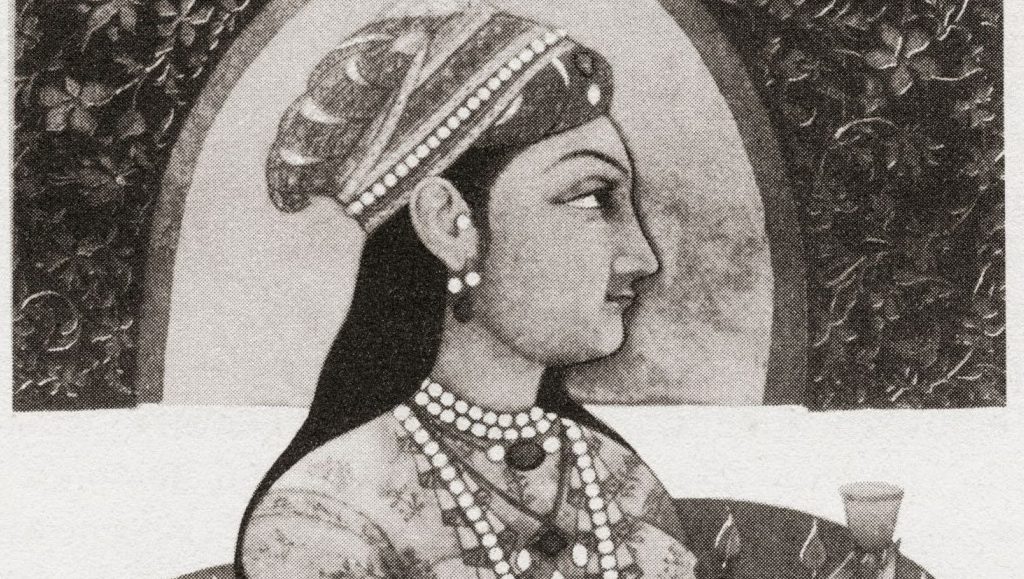By Aaliyia Malik

“Nur Jahan is the history of India”, Ruby Lal, author of the Empress: The Astonishing Reign of Nur Jahan.
Born as Mehr – un – Nissa, Nur Jahan stands as the most eminent woman in not just Mughal but Indian history. An educated, powerful woman who rose to power due to her brilliance, Nur Jahan was considered to be the power behind the throne. Her knowledge and prowess also brought along titles and honors that no other queen enjoyed. She was a poet, a skilled hunter who once saved a village from a man-eating tiger by shooting it dead with her musket, a skilled architect and an even more powerful politician.
Nur wasn’t born a royalty and was married at the age of 17 to a Persian soldier, Sher Afghan, who was the then governor of Bihar. Soon Sher Afghan died leaving a very young widow. Three years later, Nur Jahan agreed to marry Emperor Jahangir and became his 20th and final wife. She was the queen of the empire when it was at the peak of its glory and power and was more powerful and proactive than her husband.
Nur’s rise to power
Soon after her marriage to Emperor Jahangir, her intelligence and knowledge made her a force to reckon with. As the Emperor was in particular very fond of her, it facilitated her rise to power within the empire. Her power within state affairs grew and what also grew was her importance within the realm. She received audience besides her husband at the Jharoka, issued orders, oversaw the administration of the jagirs and even consulted ministers.
After her marriage she signed her first royal order to protect the land rights of an employee. Her signature read, “Nur Jahan Padshah Begum”, which translates to Nur Jahan, the Lady Emperor.
Nur was also an excellent hunter and possessed great strength and power. She often went on hunting sprees with her husband and was known for killing ferocious tigers. Her valor inspired many poets to write about her, such as this,
“Though Nur Jahan be in form a woman,
In the ranks of men she’s a tiger-slayer”
— Unknown Poet
In 1617, gold and silver coins which bore her name alongside Emperor Jahangir started circulating. In 1626, Jahangir was captured by a rebellious group led by Mahabat Khan who wanted to take control of the reign. Nur Jahan ordered the ministers to plan an attack in order to release the Emperor. She herself led a unit by riding a war elephant and moved towards Mahabat Khan’s camp. Unfortunately, she too was captured by the forces. However, even in captivity she came up with a plan to escape by raising an army. She also had a very special connection with women who were less fortunate and even provided them with land and paid dowries for poor orphan girls.
Nur often showcased traits that defied patriarchy and the rules laid down for women at that time. According to legend, she once surprised visitors by showing up at the imperial balcony which was reserved for men. She had also protected the borders in the absence of the Emperor. But this wasn’t the first time she had disobeyed rules. As author Ruby Lal describes Nur that Nur Jahan was a Shia Muslim, but “married a Sunni king who had a Hindu mother and both Hindu and Muslim wives and concubines.”

Poetry
“Thy love has melted
my body and it has become water.
Any antimony that might have remained
became the antimony of the bubble’s eyes.
The bud may open by the morning breeze which blows in the garden,
but the key to the lock of my heart is the smile of my beloved.”
– Translated by Barakat Ullah (From the anthology ‘Poems by Indian Women’ Ed by Margaret Macnicol, 1923)
Nur was also an acclaimed poet. Although very few records remain of her works, she was an admirer of art, so much that on her tomb she inscribed the following:
“On the grave of this poor soul be so good as to light no lamps nor strew any roses. This will ensure that the wings of moths do not get singed and that nightingales will not sigh and weep and lament”.
After Jahangir’s demise, Nur wanted her son – in – law Shahryr who was also Jahangir’s youngest son to take over the throne. However, she faced stiff opposition for this and Shah Jahan eventually succeeded to the throne. After this she spent the last few years of her life in a mansion in Lahore. She received an allowance of 2 lakh rupees from Shah Jahan. During this time, she supervised the construction of her father, Mirza Ghias Beg’s mausoleum. Nur eventually passed away on 17th December 1645 and was buried in all her glory at Shahdara Bagh in Lahore.
What Nur achieved in her lifetime was a great challenge to the patriarchal customs and norms which limited a woman’s role only to her husband. An educated and learned woman, she commissioned expensive buildings which were symbols of art. She has also been credited to introduce a number of textiles in her lifetime. She became a symbol of power and intelligence and not only women of that era but generations to come.

